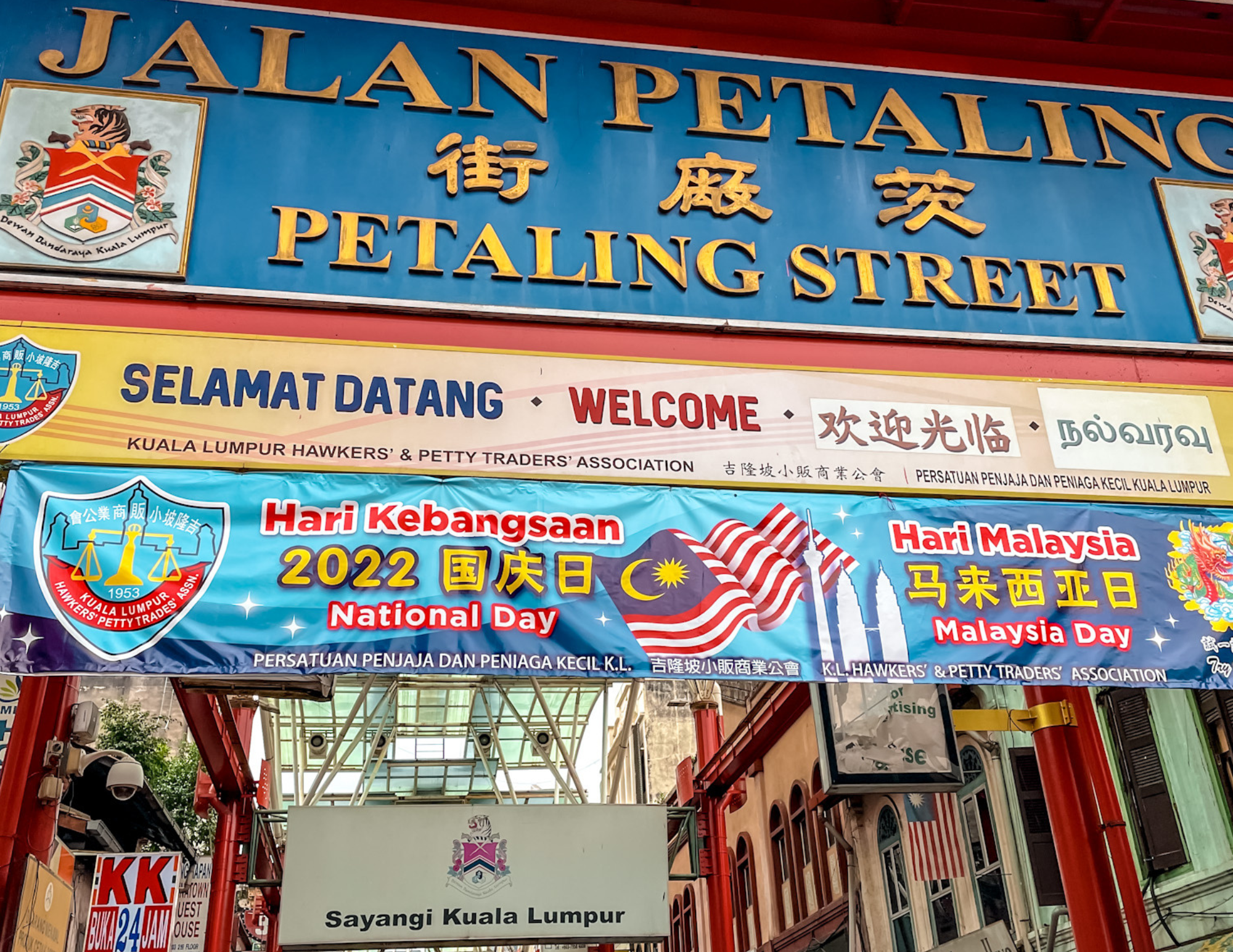Updated October 2025
Wherever I travel I end up in Chinatown, and Petaling Street is that magnet in Kuala Lumpur, lanterns overhead, steam from woks, vendors calling out deals, and tables spilling into the lane. It’s touristy and still irresistible: you can graze through noodles and desserts, pick up accessories and souvenirs, and jump to murals or temples within a few minutes’ walk. Even if I’m not shopping, I come for the atmosphere and a late snack, then wander into the back alleys to see what’s changed since my last visit.

HOW TO GET THERE (NO-TRAFFIC VERSION)
Take the train: ride the LRT Kelana Jaya Line or MRT Kajang Line to Pasar Seni Station and follow the signs for Entrance A (Jalan Sultan) that drops you a short stroll from Petaling Street and the heart of Chinatown. The LRT/MRT interchange is integrated, with linked concourses, so transfers are easy. If you’re arriving by monorail (Maharajalela), it’s a 10–12 minute walk. Trains beat evening road traffic every time.

WHEN IT’S MOST ALIVE (AND HOW LONG TO STAY)
The market trades by day, but late afternoon into night is when Petaling Street really feels like itself, stalls are fully up, footfall picks up, and food lanes wake. Many guides cite roughly 10:00–21:30 for market hours, with some stalls only opening after 5 pm and certain food spots running past midnight. I budget 90 minutes to 2 hours if I’m eating and browsing; longer if I’m layering in temples and murals.

WHAT IT IS (IN A NUTSHELL)
Petaling Street is KL’s classic open-air market street in Chinatown: accessories, apparel (lots of negotiable fashion), souvenirs, phone cases, small electronics, plus a shoulder-to-shoulder lineup of hawker bites and sit-down Chinese-Malaysian restaurants. It’s loud, lively, and built for browsing; you come to compare, haggle a little, and snack your way down the lane.

WHAT TO EAT
I move in courses: a noodle (think char kway teow or wantan mee), a roast-meat plate (char siew or roast duck), something claypot (claypot chicken rice is a staple), and a sweet finish, ais kacang or a cold herbal tea. If I’m with my teen, we add street desserts and fruit juices between shops. Menus are posted and English is widely understood; if a place is slammed with locals, I join the queue and treat that as the recommendation.

SHOP SMART (CASH, BARGAINING, QUALITY)
Bring small bills and be ready to politely bargain (10–30% wiggle room on fashion and souvenirs is common). Inspect stitching and zippers, check electronics before paying, and confirm prices for multi-buy deals. Most stalls are fine with a quick photo of the price board, but I always ask first. Increasingly you’ll find e-wallet/QR options, but cash still moves fastest.

WHAT’S NEXT-DOOR (PAIRINGS THAT MAKE SENSE)
• Central Market (Pasar Seni) & Kasturi Walk: A covered heritage market with handicrafts and a parallel outdoor lane; a few minutes from Petaling Street and good for AC and bathrooms between shopping rounds. Typical operating window is 10:00–21:30.
• Kwai Chai Hong (mural alley): An atmospheric back lane of murals and rotating art installations off Lorong Panggung, small but creative, and an easy 5-minute walk from Pasar Seni. Best early or near sunset for photos.
• Sri Mahamariamman Temple: KL’s oldest Hindu temple sits at the edge of Chinatown. Visitors are welcome outside prayer times; modest dress (shoulders/knees covered) and shoes off inside are the norm.
• River of Life (evening): If you stay after dark, hop one LRT stop (or walk) to Masjid Jamek for the blue-lit river/mist sequences around 9 pm, great night photos and an easy add-on to a Chinatown dinner.

SAFETY & COMFORT (WHAT I ACTUALLY DO)
I wear a cross-body bag zipped, keep my phone on a wrist strap in tight crowds, and step out of the main flow when I want to check a map. Petaling Street is busy and feels safe, but petty theft happens in any dense market, basic street smarts go a long way. For heat or rain, I duck into Central Market or a café on Jalan Sultan until the weather passes; stalls come back to life quickly after a shower.

A SIMPLE LOOP TO COPY
Arrive via Pasar Seni Station before sunset → browse Petaling Street while it warms up → sit for noodles/roast meats → cut through side lanes for dessert and accessories → pop to Kwai Chai Hong for a mural lap → finish at Central Market/Kasturi Walk for souvenirs and AC → if it’s late, jump one stop to Masjid Jamek for River of Life photos, then train home.

TINY FAQ (THE THINGS PEOPLE ASK ME)
Are prices fixed? Often not, smile, ask, and meet in the middle.
Cards accepted? Some, but cash is king at stalls.
Dress code? Regular streetwear is fine; if you enter temples, cover shoulders/knees and remove shoes.
Best time for photos? Late afternoon into blue hour, lanterns glow, and the market is fully awake.
Closest station? Pasar Seni (LRT/MRT), follow the signs to Jalan Sultan / Chinatown exits.

